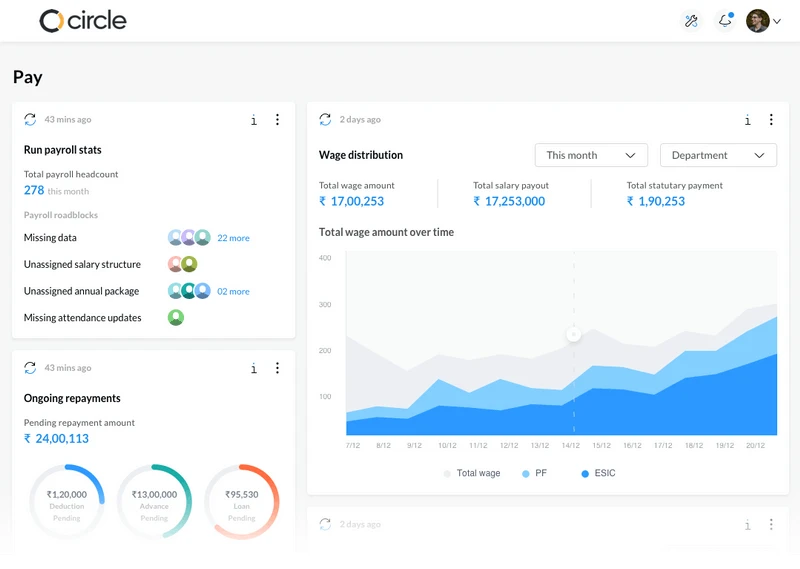You may have noticed the terms ‘wage’ and ‘salary’ being used interchangeably within a conversation. So, are they the same thing? How are they different? Which is the better system? Wages and Salary are both forms of compensation paid to an employee by a company. They are, however, very different in their structures. In the following sections, we will be explaining to you these differences in great detail. We will also elaborate on what exactly wages and salaries are and which system best matches your needs.
2. What are wages?
A wage is essentially what an employer pays an employee in exchange for the service that employee is providing to an organization. Wages are generally paid weekly on the basis of the work the employee performed in the previous week. It can be paid according to the number of hours an employee works in a week, or it could be paid by the number of tasks that the employee is performing per week.
2.1 Formal definition & meaning of wage
Section 2(h) of the Minimum Wages Act defines wages as,
‘All remuneration capable of being expressed in terms of money which would if the terms of the contract of employment express or implied were fulfilled be payable to a person employed in respect of his employment or of work done in such employment and includes house rent allowance but does not include-
(i) the value of –
(a) any house accommodation supply of light water medical attendance or
(b) any other amenity or any service excluded by general or special order of the appropriate government;
(ii) any contribution paid by the employer to any person fund or provident fund or under any scheme of social insurance;
(iii) any traveling allowance or the value of any traveling concession;
(iv) any sum paid to the person employed to defray special expenses entailed on him by the nature of his employment; or
(v) any gratuity payable on discharge. ’
2.2 Why understanding wages is important
It is crucial to have a clear understanding of how wages work and its concepts to ensure you are making the best job-related decisions. Some ways knowledge of wages can help you include:
- Gives you the ability to calculate weekly, monthly, yearly earnings yourself
When you are offered a job, the employer will generally present to you an amount that is your ‘hourly wage’. Understanding how wages work allows you to be able to take this number and accurately calculate what your weekly, monthly or annual wage will be. Being able to calculate these earnings is valuable whilst assessing if a job will be able to meet your or your family’s needs for the week/month/year.
- Allows you to narrow down job options
Understanding how your wage is calculated, what benefits it does or does not include or on what schedule you will be paid, etc can help you narrow down which jobs you will be interested in.
- Helps you understand how you can negotiate better compensation
To be able to determine whether or not you are being compensated fairly, knowledge of the wage system is essential. It allows you to be able to ask your employer the right questions and re-negotiate your pay if you feel the current offer is inadequate.
- Expanding your skill set if you wish to work in finance or accounting
If you’re looking to join the fields of finance or accounting, knowledge of wages will be a must. If you’re already working in Payroll Staff, finance, or accounting, expanding your understanding of different types of wages can help elevate you to new roles and expand your job options.
2.3 Types of wages
On the basis of how they are calculated:
- Time wages
Time wages are calculated according to the total number of hours per week. These employees are referred to as hourly employees.
For example:
Employee Ahaan (Works at a notebook making factory)
No. of Hours Worked: 30hrs
No. of Notebook Pieces Made: 12
Hourly Rate: ₹500
Piece Rate: ₹500
According to time wages, wages payable will be 30*500 = ₹15,000 for that week
- Piece wages
Wages are calculated according to the total number of tasks/pieces completed in that week.
For example:
Employee Ahaan (Works at a notebook making factory)
No. of Hours Worked: 30hrs
No. of Notebook Pieces Made: 12
Hourly Rate: ₹500
Piece Rate: ₹500 per piece
According to piece wages, wages payable will be 12*500 = ₹6000 for that week
On the basis of method of payment:
- Wages in kind
Wages in Kind refers to payment in the form of goods or commodities instead of actual money. This method is generally only used in rural areas.
- Cash wages
Cash wage is the more commonly used form of compensation. Cash wages imply compensation in the form of cash/money.
On the basis of amount:
- Minimum wage
Minimum wage is the minimum amount an employee must be paid by their employer. This is the lowest possible wage that ensures that the bare minimum food, clothing and shelter needs of the employee and their family are met. The minimum wage of a country/state is determined by the government and revised periodically.
Minimum Wage ensures that:
- Employers do not exploit their employees
- Employees with little negotiation skills or education are not taken advantage of
- Workers are compensated fairly enough to produce good quality products
- High-quality employers do not lose out to competitors creating cheaper, lower quality products from underpaying employees.
- Living wage
Article 34, Draft Constitution of India, 1948 states,
‘The State shall endeavour to secure, by suitable legislation or economic organization or in any other way, to all workers, industrial or otherwise, work, a living wage, conditions of work ensuring a decent standard of life and full enjoyment of leisure and social and cultural opportunities.’
A living wage rate is a level of wage that not only allows you to survive but also to thrive. It ensures you have the means necessary to participate in leisure, cultural and social activities beyond your minimum survival requirements.
Similar to minimum wage, a living wage rate is determined by your central/state government and revised with time.
- Fair wage
Similar to the living wage, a fair wage is another range of wages. Its lower limit or base wage is minimum wage and the upper limit is the maximum capacity the organization can pay that is comparable to the average pay observed in other trades requiring similar skills or performing similar tasks.
2.4 Real wages and money/nominal wages
The amount of money finally received by a worker post the production process is referred to as money/nominal wage.
Real Wage, on the other hand, is not as straightforward. It refers to the translation of the amount received into the terms of what that money can actually buy.
For example, if a worker can buy a certain amount of petrol a month with his current wage and then the cost of petrol goes up by 50%, then the real wage of the worker will reduce by 50% as now he can afford less petrol.
2.5 What factors cause varying wages?
Wages vary greatly between industries and regions. Here are some factors that affect how wages exist in a certain industry/area:
- Worker supply: If there is a great supply of workers, then negotiating higher pay becomes difficult as the organization can simply hire someone else who will accept lower pay. Hence greater worker supply results in lower wages. Similarly, a low worker supply allows for an increase in money wages.
- The ability of the organization: Every organization has a certain budget within which they can distribute employee wages depending on their profits. Hence wages can vary greatly between organizations.
- The ‘Going Wage Rate’: The average wage being paid for similar jobs in the region is generally referred to as the going wage rate or normal wage rate. Companies tend to adhere fairly closely to these rates in cooperation with their competitors and to maintain an overall peaceful atmosphere and quality of work.
- Trade union power: Some regions have more powerful trade unions than others and an area with a strong trade union will certainly see an increase in money wages.
- Job difficulty: Jobs that are of high difficulty or require a more specific skill set will have higher hourly wage rates as the hourly employees with the capability for these jobs is less.
3. What are salaries?
A salary refers to the regular amount an employee is paid for being employed under an organization. A salary is generally presented as the amount earned annually but salary payments are made to an employee on a monthly basis.
3.1 Formal definition of salary
“A fixed compensation periodically paid to a person for regular work or services.” – Dictionary.com. A salary is usually supplemented with other benefits such as healthcare, paid leave, insurance benefits, etc.
3.2 Types of salary
- Net Salary: The amount you actually get paid after all reductions.
- Gross Salary: The salary that shows on your income statement excluding all deductions such as Income Tax.
- CTC: The cost to the company for maintaining that employee. Here is where the company-provided benefits like Health Insurance are included.
4. Difference between salary and wages

The following table illustrates the main differences between salary and wages:
Comparison Basis
Wage
Definition
A variable weekly wage paid to an individual based on the number of hours worked/tasks performed
A fixed annual salary is paid to an individual on a regular basis as long as they are meeting their minimum employment expectations
Amount paid
Variable
Fixed
Payment schedule
Per Business Day/Weekly wage
Monthly
Skill of employee
Generally semi-skilled or unskilled
Generally highly skilled
Payment rate
Hourly-Rate
Fixed-Rate
Overtime pay
Extra pay for extra hours is ensured
Extra pay for extra working hours is not ensured (some companies pay for overtime but not all)
Benefits
Employees are not given as many additional benefits
Employees are generally given added benefits like healthcare, insurance, paid leave, etc.
4.1 Advantages of wages
Here are some advantages you may get through the wages system:
- Flexibility: Self-set hours allow for you to make time for other interests or develop new skills.
- Overtime: You are paid extra money for working longer(with time-based wage) or harder (with piece-based wage).
- Less responsibility and pressure: A wage-paid employee is a more casual worker and is generally given low-pressure tasks which can be covered up by other workers if one employee slacks for the day.
- Employment contracts and conditions aren’t as rigid: A salaried worker is generally bound by rigid contracts, whereas waged employees have it easier if they wish to change jobs.
4.2 Advantages of salary
Here are some advantages you may get through the salary system:
- Consistency: Employees are paid consistently, ensuring stress-free steady income.
- Greater responsibilities result in higher pay: Salaried employees are given more opportunities for promotion and greater responsibility. These higher roles pay higher salaries.
- Benefits: Additional employment benefits like maternity/paternity leave, paid vacation time, insurance, etc. are attractive perks of a salaried employee.
5. Conclusion
Neither salary pay nor wage pay is necessarily ‘better’ than the other. The right one for you will depend on your situation and career goals. The important thing is to ensure you are fluent in the related terms and concepts to ensure you’re making informed decisions that will propel you in the right direction.
6. FAQs
6.1. How is minimum wage calculated in India?
Indian labour conference held in 1957 constructed the following guidelines to calculate minimum wage:
(i) 3 consumption units per earner.
(ii) Least food requirements of 2700 calories per average adult.
(iii) Clothing provisions of 72 yards per family per annum.
(iv) Rent compared to the minimum area given under the Government’s Industrial Housing Scheme.
(v) Fuel and other miscellaneous stuff of expenditure to aggregate 20% of the total minimum wage.
6.2. How often are minimum and living wages revised?
According to the Minimum Wages Act, 1948, both the Central and State governments have power over setting minimum and living wages. Wage boards are set up to revise and set minimum wages at specified intervals which can differ from state to state. Average wages differ across states, sectors, skills, regions, and occupations due to many differentiating factors. Hence, there is no single uniform minimum wage rate across the country and the revision cycle differs for each state.
6.3. Which acts have been passed regarding wage legislation?
- The Payment of Wages Act, 1936: Regulates the payment of wages to certain classes of persons employed in the industry. It also stipulated the payment for working overtime and deduction of wages.
- The Minimum Wages Act, 1948: Aimed to provide minimum (statutory) wages for scheduled employments and eliminate chances of exploitation of labour through payment of very low and sweating wages.
- The Equal Remuneration Act, 1976: This act emphasizes equal payment of wages to men and women wage earners who are engaged in identical employment.
- The Payment of Bonus Act, 1965: Provides for payment of bonus to workers in all establishments/factories in which 20 or more persons are employed on any day, covered in the related accounting year.
6.4. How can I choose between a wage or a salary system?
If you are highly skilled, require a steady income, or wish to pursue further promotions in the organization, then a salary system would be better suited for you. However, if you require more flexibility, are semi-skilled/unskilled, need the option to balance multiple jobs, or switch jobs suddenly, then a wage system is probably the way to go.
6.5. Can I negotiate trading a portion of my cash entitlement for a non-cash benefit?
Yes, this is termed as a ‘Salary Sacrifice’ and is a formal private agreement between an employee and employer. The reduction in cash entitlement however cannot drop below minimum wage.
Also if you are looking for HRMS to manage your employees salary account on a monthly basis head over to www.sumhr.com and get started with the all in one HR & Payroll software in India








